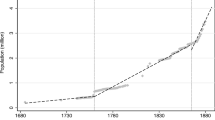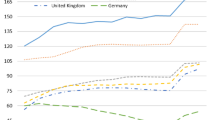Abstract
Aspects of below-replacement fertility have long been debated among professional demographers. This paper describes the corresponding popular debate about low fertility by analyzing 437 newspaper and magazine articles from eleven developed countries during 1998 and 1999. Despite the diversity in the national debates due to different socioeconomic, political and demographic backgrounds, our study finds important commonalties in the way low fertility is debated: First, countries emphasize consequences and potential interventions rather than causes in their popular debates over low fertility. Second, our study reveals that the popular press discusses low fertility as a serious concern with mostly negative implications, despite the fact that many of the causes of low fertility are associated with social and economic progress. Third, the variety of issues and perspectives revealed in the popular debate, while cohesive in general ways, invites a role for demographers in informing an accurate public discussion of low fertility, which will help form the most appropriate policy outcomes.
Similar content being viewed by others
References
Ahn, Namkee & Mira, Pedro (1998), Changing relationship between fertility and female employment in developed countries, paper presented at the Annual Meeting of the European Society for Population Economics, Amsterdam.
Bongaarts, John & Feeney, Griffith (2000), On the quantum and tempo of fertility: A reply, Population and Development Review 26(3): 560-564.
Clarke, J. I. (1996), The impact of population change on environment: An overview, in Bernardo Colombo, Paul Demeny & Max F. Perutz (eds.), Resources and Population: Natural, Institutional and Demographic Dimensions of Development, Oxford: Clarendon Press.
Coale, Ansley J. (1986), Demographic effects of below-replacement fertility and their social implications, Population and Development Review 12(supplement): 203-216.
Demeny, Paul (1997a), Replacement-level fertility: The implausible endpoint of the demographic transition, in G.W. Jones, R. M. Douglas, J. C. Caldwell & R. M. D'Sousa (eds.), The Continuing Demographic Transition. Oxford: Clarendon Press.
Demeny, Paul (1999), Policy Interventions, in United Nations, Population Division 1999, Below Replacement Fertility, Population Bulletin, Special Issues Nos. 40/41.
Espenshade, Thomas J. (1986), Population dynamics with immigration and low fertility, Population and Development Review 12(supplement): 248-261.
Foster, Caroline (2000), The limits to low fertility: A biosocial approach, Population and Development Review 26(2): 209-234.
Gauthier, Anne Helene (1996), The State and the Family: A Comparative Analysis of Family Policies in Industrialized Countries, New York: Oxford University Press.
Gauthier, Anne Helene (2001), The impact of public policies on families and demographic behaviour. Paper presented at the EURESCO Conference on the Second Demographic Transition, Bad Herrenhalb, Germany, June 23-28 (available at http://www.demogr.mpg.de/Papers/workshops).
Golini, Antonio (1998a), Demographics, public spending and social programs, Labour 12(1): 119-141.
Golini, Antonio (1998b), How low can fertility be? An empirical exploration, Population and Development Review 24(1): 59-74.
Heer, David M. (1986), Immigration as a counter to below-replacement fertility in the United States, Population and Development Review 12(supplement): 262-269.
Hoem, Britta (2000), Entry into motherhood in Sweden: The influence of economic factors on the rise and fall in fertility, 1986-1997, Demographic Research 2(4): online at http://www.demographic-research.org.
Hoem, Jan M. (1990), Social policy and recent fertility change in Sweden, Population and Development Review 16(4): 735-748.
Hoem, Jan M., Prskawetz, Alexia & Neyer, Gerada (1999), Autonomy or conservative adjustment? The effect of public policies, educational attainment on third births in Austria, 1975-96, Population Studies 55(3): 249-262.
Hotz, Joseph V., Klerman, Jacob A. & Willis, Robert J. (1997), The Economics of Fertility in Developed Countries, in Mark R. Rosenzweig & Oded Stark (eds.), Handbook of Population and Family Economics, Amsterdam: Elsevier.
Kohler, Hans-Peter, Billari, Francesco C., & Ortega, JoséA. (2002), Towards a theory of lowest-low fertility, Population and Development Review forthcoming.
Kohler, Hans-Peter & Philipov, Dimiter (2001), Variance effects and nonlinearities in the Bongaarts-Feeney formula, Demography 38(1): 1-16.
Kohler, Hans-Peter, Rodgers, Joseph L. & Christensen, Kaare (1999), Is fertility behavior in our genes: Findings from a Danish twin study, Population and Development Review 25(2): 253-288.
Kreyenfeld, M. & Hank, K. (2000), Does the availability of childcare influence the employment of mothers? Findings from western Germany, Population Research and Policy Review 19(3).
Lee, Ronald D. (2000), Long-term population projections and the US social security system, Population and Development Review 26(1):137-143.
Lee, Ronald D. (1994), The formal demography of population aging, transfers, and the economic life cycle, in L. Martin & S. Preston (eds.), The Demography of Aging, Washington, D.C.: National Academy Press.
Lesthaeghe, Ron (1983), A century of demographic and cultural change in Western Europe: An exploration of underlying dimensions, Population and Development Review 9(3): 411-435.
Lesthaeghe, Ron & Willems, Paul (1999), Is low fertility a temporary phenomenon in the European Union?, Population and Development Review 25(2): 211-229.
McDonald, Peter & Kippen, Rebecca (2001), Labor supply prospects in 16 developed countries, 2000-2001, Population and Development Review 27(1): 1-32.
Macunovich, D. J. (1996) Relative income and price of time: exploring their effects on US fertility and female labor force participation, Population and Development Review 22(supplement): 223-257.
Martin, Linda G. & Preston, Samuel H. (1994), The Demography of Aging. Washington, D.C.: National Academy Press.
Morgan, S. Philip & King, Rosalind B. (2001), Why have children in the 21st century? Biological predispositions, social coercion, rational choice, European Journal of Population 71(1): 3-20.
Namboodiri, K. & Wei, L. (1997), Fertility theories and their implications how low can low fertility be, paper presented at The Twenty-third IUSSP General Population Conference, Beijing.
Rindfuss, Ronald R., Benjamin, Karen & Morgan, S. Philip (2000), The changing institutional context of low fertility, paper presented at the annual meeting of the Population Association of America, Los Angeles.
Rogers, Everett & Storey, J. Douglas (1995), Communication campaigns, in Charles R. Berger & Steven H. Chaffee (eds.), Handbook of Science Communication, London: Sage Publications.
Teitelbaum, Michael S. & Winter, Jay (1985), The Fear of Population Decline. London: Academic Press.
Teitelbaum, Michael (1999), Consequences of sustained below-replacement fertility, in United Nations, Population Division 1999, Below Replacement Fertility, Population Bulletin, Special Issues Nos. 40/41.
Teitelbaum, Michael S. & Winter, Jay (1998), A Question of Numbers: High Migration, Low Fertility and the Politics of National Identity. New York: Hill & Wang.
United Nations (1989), Trends in population policies, no. 114 in Population Studies. New York: United Nations.
van de Kaa, Dirk J. (1987), Europe's second demographic transition, Population Bulletin 42(1): 1-57.
Wachter, Kenneth W. (1997), Kinship resources for the elderly, Philosophical Transactions of The Royal Society of London Series B, Biological Sciences 352(1363): 1811-1817.
Weil, David N. (1997), The economics of population aging, in Mark R. Rosenzweig & Oded Stark (eds.), Handbook of Population and Family Economics, Amsterdam: Elsevier.
Wilmoth, John R. & Ball, Patrick (1992), The population debate in American popular magazines, 1946-90, Population and Development Review 18(4): 631-668.
Zoubanov, Anatoly (2000), Population ageing and population decline: government views and policies, United Nations Expert Group Meeting on Policy Responses to Population Ageing and Population Decline, October 16-18, New York.
Author information
Authors and Affiliations
Rights and permissions
About this article
Cite this article
Stark, L., Kohler, HP. The debate over low fertility in the popular press: A cross-national comparison, 1998–1999. Population Research and Policy Review 21, 535–574 (2002). https://doi.org/10.1023/A:1022990205200
Issue Date:
DOI: https://doi.org/10.1023/A:1022990205200




